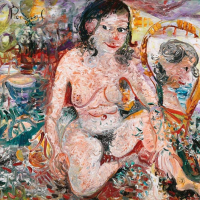54. JOHN PERCEVAL

As many will testify, the world created in an artists work might not necessarily show a direct relationship to the artists own life. The paintings and ceramics of John Perceval are amongst the most appealing and engaging of any artist of his generation, but the bright and happy world they depict was far from his broader life experience. Perceval was the product of a deeply troubled home life, made all the more difficult by his contracting poliomyelitis at the age of just fifteen. He spent a year in hospital recovering from the disease, the only bright spot being that during his recuperation he was able to work on his drawing and painting as part of the occupational therapy program. Despite the disability of a withered leg, he was able to serve in the Army during the second World War, with the happy consequence of meeting a fellow artist in the Survey Corps, Arthur Boyd (1920-1999). The meeting had profound outcomes for Perceval, who married Boyds sister Mary and worked with the Boyd family in the creation of Murrumbeena Pottery. His mastery of the ceramic medium produced some of the most memorable examples of the craft ever made in this country, the series of angels depicting in glazed terracotta the antics of a band of boisterous, funny and thoroughly naughty denizens of a happier world.
Perceval took his family to live in the suburb of Williamstown on the working side of Hobsons Bay and, under the obvious influence of his brother in law, Arthur Boyd, began to paint the world on his doorstep. The rundown piers and wharves, the rusting hulks and the working tugs filled his lively canvases. Swans and gulls splash in the shallow waters against the backdrop of the big city. There was a joy and almost manic enthusiasm in the Williamstown paintings, full of colour, lush brushwork and a simple joy in the act of creation. They found a ready market in the booming 1960s, their affinity with the works of Vincent Van Gogh (1853-1890) providing the perfect backdrop to a new group of collectors looking beyond the timid watercolours and safe flower studies of the previous generation. Success with the Williamstown works took Perceval further afield, bringing his bright and boisterous vision to the landscapes on the edge of the city. In 1959 he joined with Arthur and David Boyd (1924-2011), John Brack (1920-1999), Robert Dickerson (1924-2015), Charles Blackman (born 1928) and Clifton Pugh (1924-1990) to form the Antipodeans, a group dedicated to a figurative art in opposition to the abstraction and non-objective painting coming from America and Europe.
Perceval also brought his vision of a pleasurable and vibrant world to figure painting. In his seminal work of 1956, The Nude, A Study in Ideal Form, Sir Kenneth Clark proposed a theory of The Nude, as compared to the image of a person without clothes. Percevals Kathy in the Studio sits very squarely in the latter camp. It is a fun and disarmingly direct study of a young woman seated on the artists floor. She does not affect some classical pose, discreetly and elegantly turning to protect some semblance of modesty, but lounges about, legs akimbo while laughing at a shared joke. To a public only just accepting the nineteenth century nude Chloe, the infamous tenant of Young and Jacksons Hotel, such a blatant and enthusiastic depiction of female sexuality would have been particularly challenging. In decades to come alcohol and mental illness might have blighted his life, but the 1960s was his time to shine and this is Perceval at the height of his powers, confident of his place in the Australian art world.
Gavin Fry BA[Hons], MA, M.Phil